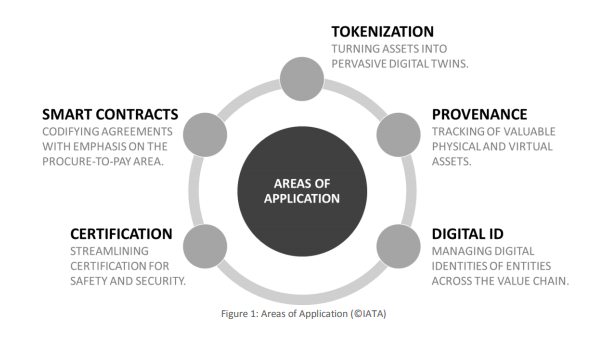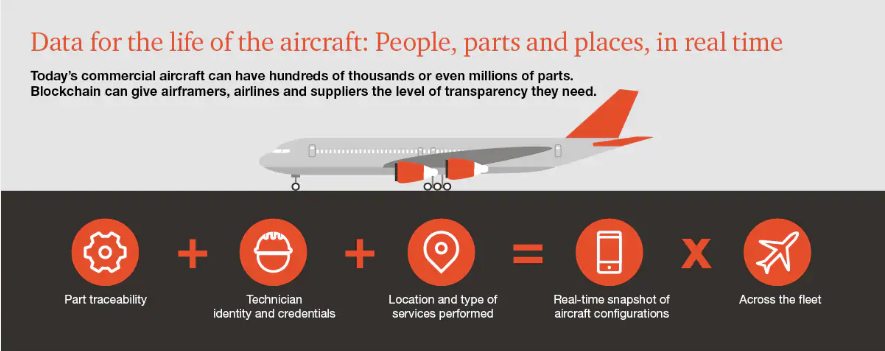-
Aviation businesses and their suppliers have been exploring Blockchain for aviation applications like blockchain supply chain development. The initial progress is visible enough to entice further research and development beyond prototypes. The rise of new technology is often accompanied by a lot of speculation. To some degree, Blockchain is exhibiting characteristics similar to those seen at the dawn of the Internet, with the potential to have a similarly disruptive effect as it matures. Let's see if development solutions provided by blockchain for aviation can relieve some of the industry's pain points and open up more lucrative opportunities.
Fundamentals of Blockchain
Blockchain technology is exciting, revolutionary, and disruptive, and it is conceptually a database. Unlike conventional data storage, which depends on a central infrastructure with backups and replication, Blockchain adopts a distributed architecture.
To put it simply, Blockchain technology is a decentralized ledger that often makes use of crowd computing and resources, such as mining.
Unique Blockchain Applications in Aviation
Maintenance is Important
Boost productivity. Reduce the amount of time you spend on routine repairs and inspections. Vendors of mercenary pieces must be defeated. Compare the serial number of a part for sale to an indelible, real-time record of possession, place, and use. Rethink how aircraft are maintained. Increase the amount of maintenance that is scheduled ahead of time. Reduce the number of delays and revenue missed. Guarantees should be used instead of warranties. Allow for the expansion of service agreements under which a supplier is responsible for the delivery, repair, and overhaul of components and systems.
Strengthen Financing
Invest in the secondary market to maximize your worth. Extend jet engine maintenance requirements to the entire aircraft, using verifiable maintenance records in real-time. Transform the leasing industry. The need to disassemble an aircraft to inventory its parts and determine their condition is no longer necessary. Insurance should be strengthened. Individual planes should be insured in a way that represents their danger.
Streamline Management
With biometric identity authentication, blockchain technology will make it possible to ensure that the identity of anyone who communicates with a plane – as well as the status of their credentials – is included in a real-time snapshot of its state.

Source IATA
Blockchain Development Types
There are four different kinds of Blockchain, also known as "Advanced Ledgers." The classification begins with whether the chain is open to the public and then moves down to whether the chain can be checked with (i.e. permissioned) or without (i.e. permissionless) permission. Blockchain networks currently fall in the category of either centralized or decentralized. Every variation has its own set of benefits and drawbacks.
Also, Read | Types of Blockchain and their Importance in the Digital World
Blockchain-Enabled Possibilities in Aviation
The commercial aviation industry is a highly dynamic industry. It involves a large number of companies in the distribution of travel goods and services. From the viewpoint of a consumer, it often manifests as a single product. These actors also collaborate and cooperate to co-deliver value and fulfill consumer expectations. The airline comprises only one of about 26 business partners usually involved in the aviation chain. It starts from the moment travelers check online for an air ticket to the time they arrive at their destination.
Multi-Benefit Loyalty Management
Frequent Flyer Miles are a type of loyalty program that allows you to
by tokenizing these assets and rendering them digital and ubiquitous. Blockchain for loyalty management has the potential to dramatically streamline the receiving, spending, accounting, and reconciliation of frequent flyer points. While the steady increase in passenger load factors is good news, it makes it more difficult for airlines to make point redemption easier. Aside from the balance sheet liability problem, the process of winning, redeeming, and exchanging points, especially across alliances, is ripe for innovation.From Spare Part to Luggage Management, Strengthened Supply Chain
As precious assets such as passenger bags, cargo, and aircraft spare parts change ownership, the blockchain supply chain solutions allow for very secure and immutable monitoring of their status and place. When these things pass across the supply chain, blockchain offers an opportunity to improve visibility and accountability. These new capabilities can open up new product development areas, assist in process streamlining, and equip providers to deal with disturbances.
Faster, Safer, and Advanced Payments and Transactions
Airlines, travel agents, and those in the distribution space will better communicate when providing travel goods and services using blockchain. The anticipated changes will broaden both parties' distribution scope and improve the efficiency with which travel product and service aggregation happen. Blockchain for payment solutions also has the potential to make payments more transparent, real-time, and low-cost.
Identity Management Solutions
Blockchain identity management solutions have the potential to simplify passenger identity management while also preserving privacy and allowing airlines and the broader value chain to conduct business in digital environments.
Smart Contracts Development for the Entire Aviation Value Chain
Airlines and other value chain players exchange goods and services and devote considerable resources to contracts, contract execution, delivery stage monitoring, reconciliation, invoicing, and settlement. Using the principle of Smart Contracts, both of these efforts can be minimized or greatly simplified. Smart Contracts can run on their own, triggered by neutral data sources and pre-defined conditions.

Source PWC
Entering Blockchain development, Feasible or Not?
It is not an easy decision to accept Blockchain as a solution to a problem. The hype and the fear of losing out both play an unwelcome role, and as a consequence, decision-making can become slightly skewed and technology-focused. On the other hand, there are several scenarios in which the technology is ideal and may be an excellent fit.
As a general rule, Blockchain works well in situations where multiple parties must create trust. Incumbent middlemen may be currently filling this position. Although disintermediation has a heroic ring to it, it isn't always a good idea to cut out the middleman. Particularly, it is important when there are rivalry, preference, and dissemination of useful services.
Furthermore, intermediaries often assume risks and obligations that companies may have outsourced for strategic reasons. The decision diagram 22 below is a guide for testing use cases and evaluating whether Blockchain is an effective solution to the problem at hand.
Also, Read | Transforming the Processes of the Aviation Sector with Blockchain
The Blockchain Initiatives focused on Improving the Aviation Industry's Ecosystem
With the support of Microsoft Azure, GE Aviation, which supplies jet engines to roughly 60% of the world's airlines, has developed a supply chain track-and-trace blockchain. Singapore Airlines Kris-flyer: Frequent Flyer Program is using Blockchain to simplify the redemption of points and other incentives, among other things. Boeing has filed a patent for a GPS anti-spoofing device based on Blockchain technology. Airbus, a French airplane maker, has joined the Hyperledger Project, a blockchain effort led by the Linux Foundation. Winding Tree Partnership is a collaboration between Air France, KLM, and Air France. Lastly, other major aviation blockchain initiatives include names like Lufthansa/SAP/SITA.
Explore more about blockchain's potential in the aviation industry with the help of the industry skills and expertise of blockchain developers.

Our Offices
INDIA
Emaar Digital Greens, Sector 61,
Gurugram, Haryana
122011.
Welldone Tech Park,
Sector 48, Sohna road,
Gurugram, Haryana
122018.














